The current warm and clammy weather provides the ideal climate for flystrike.
The main factors to consider when choosing the product to prevent blowfly are the length of prevention offered, the speed of action and withdrawal periods.
Temperature rises through the summer can spur on fly activity, increasing the risk of flystrike.
Shearing will protect ewes to some extent by removing wool cover and dirty wool on the rear. However, skin damage caused by shearing can result in flies being attracted to the area and give grounds for an initial strike. It is essential to keep a close eye on lambs also.
Dirty lambs in particular should be watched closely each day.
Sheep should be checked daily during periods of high risk to ensure that if flystrike has occurred that it is detected and treated quickly. Some obvious signs of flystrike are agitated sheep that walk quickly with tail-swishing and/or nibbling at the affected area. The presence of maggots will generally only be detected by closer examination.
Prevention
Prevention is always better than the cure. Table 1 shows a list of products on the market for the control and treatment of flystrike, scab and ticks.
The table details the name of the most commonly used products, the active ingredient, size available, withdrawal, etc.
Cost should not be looked at solely when selecting a product; farmers should weigh up the period of cover and application type when selecting the right product for use on the farm.
One of the important factors to look at is the animal to be treated and the withdrawal period. For those with ewes or lambs coming close to slaughter, it is essential that the withdrawal periods are adhered to prior to slaughter.
Pour-ons
In the interest of keeping labour to a minimum, many farmers use pour-ons as preventatives because of their ease and speed of administration. There are five main pour on products on the market – CLiK, CLiKZin, Ectofly, Ovisect and Youngs Vector.
CLiK and CLiKZiN are the most common products used for preventing blowfly strikes. CLiK has a long withdrawal period of 40 days.
CLiKZiN is a more recent product and comes with a much shorter withholding period of seven days.
CLiKZiN have control periods of eight weeks and eight to 10 weeks, respectively.
CLiK has a much longer control period of up to 16 weeks, but this comes with a longer withdrawal period. Because of this, CLiK may not be preferred for use on lambs from early lambing flocks that will have a shorter period of slaughter. Farmers more commonly use CLiK on younger or lighter lambs where the 40-day withdrawal period will not be an issue.
Youngs Vector has a wide range of parasitic control. It is active against ticks, head flies and biting lice. It can also be used to both prevent and treat flystrike. It has a control period for the prevention of flystrikes of up to eight weeks and comes with a withdrawal period of seven days, which is similar to CLiKZiN.
As can be seen in the table, the length of protection provided differs significantly while some products only have protective features while others treat and prevent blowfly.
Pour-ons are mostly targeted at flystrike prevention.
Dips give the added benefit of having a broader spectrum of control with products offering cover against ticks, scab, lice and keds. However, where farmers are considering dipping, they should be aware that the control period with dipping products is generally shorter than pour-ons.
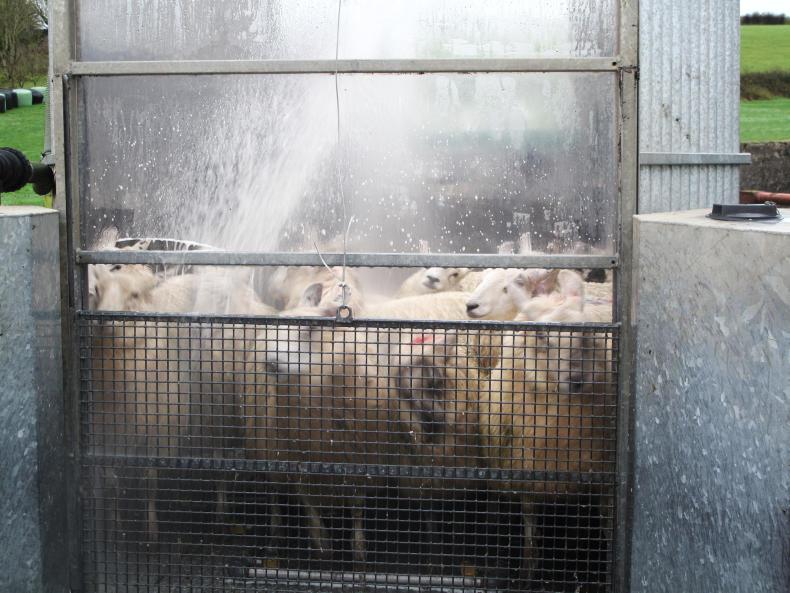
Dip products can be applied through dipping or shower/spray units with plunge dipping the only licensed method for complete sheep scab control.
It is essential when mixing the dip solution to do so to the correct concentration as specified on each product and have extra on hand to allow for losses.
Wear protective clothing
Care should be taken with all veterinary products. The first step when dosing, dipping or applying any pour-ons to sheep should be to wear protective clothing. Regardless of whether you are dosing or dipping you should have gloves, waterproof protective clothing and, in some cases, masks and goggles for eye protection. While applying pour-ons is a relatively safe process, you should still ensure that there is no contact between the product and skin.
The biggest risk factor is when handling products containing organophosphate. These can pose a significant health risk where farmers are exposed to them.
When handling these products and when dipping ewes, it is essential that full protective clothing is worn including goggles and a mask. The dipping process requires the sheep to be submerged in the dip for a short period. For that reason, there is a high risk in terms of splash contaminations.
It is important to read the product details correctly.
All products will outline the necessary safety parameters for handling each product and what to do if contamination occurs. After handling products you should always wash your hands, clothes, etc.
If handling ewes in the weeks after dipping, chemical residues may still be present. Again, protective clothing should be used along with gloves.
Dip can be a harmful substance if not disposed of correctly. For that reason, it is essential that it is disposed of correctly.
It is recommended that sheep dip be diluted at a ratio of 1:3 with dairy washings, water or slurry. Sheep dip should be spread at a rate not exceeding 5,000l/ha.
Look at the product details in Table 1 for more information.
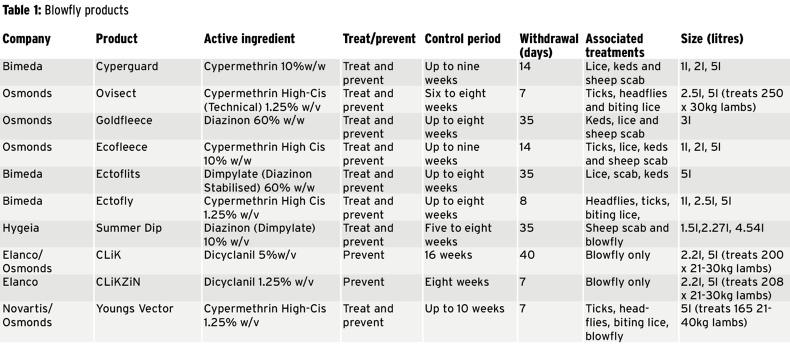
Read more
Special focus: sheep handling
The current warm and clammy weather provides the ideal climate for flystrike.
The main factors to consider when choosing the product to prevent blowfly are the length of prevention offered, the speed of action and withdrawal periods.
Temperature rises through the summer can spur on fly activity, increasing the risk of flystrike.
Shearing will protect ewes to some extent by removing wool cover and dirty wool on the rear. However, skin damage caused by shearing can result in flies being attracted to the area and give grounds for an initial strike. It is essential to keep a close eye on lambs also.
Dirty lambs in particular should be watched closely each day.
Sheep should be checked daily during periods of high risk to ensure that if flystrike has occurred that it is detected and treated quickly. Some obvious signs of flystrike are agitated sheep that walk quickly with tail-swishing and/or nibbling at the affected area. The presence of maggots will generally only be detected by closer examination.
Prevention
Prevention is always better than the cure. Table 1 shows a list of products on the market for the control and treatment of flystrike, scab and ticks.
The table details the name of the most commonly used products, the active ingredient, size available, withdrawal, etc.
Cost should not be looked at solely when selecting a product; farmers should weigh up the period of cover and application type when selecting the right product for use on the farm.
One of the important factors to look at is the animal to be treated and the withdrawal period. For those with ewes or lambs coming close to slaughter, it is essential that the withdrawal periods are adhered to prior to slaughter.
Pour-ons
In the interest of keeping labour to a minimum, many farmers use pour-ons as preventatives because of their ease and speed of administration. There are five main pour on products on the market – CLiK, CLiKZin, Ectofly, Ovisect and Youngs Vector.
CLiK and CLiKZiN are the most common products used for preventing blowfly strikes. CLiK has a long withdrawal period of 40 days.
CLiKZiN is a more recent product and comes with a much shorter withholding period of seven days.
CLiKZiN have control periods of eight weeks and eight to 10 weeks, respectively.
CLiK has a much longer control period of up to 16 weeks, but this comes with a longer withdrawal period. Because of this, CLiK may not be preferred for use on lambs from early lambing flocks that will have a shorter period of slaughter. Farmers more commonly use CLiK on younger or lighter lambs where the 40-day withdrawal period will not be an issue.
Youngs Vector has a wide range of parasitic control. It is active against ticks, head flies and biting lice. It can also be used to both prevent and treat flystrike. It has a control period for the prevention of flystrikes of up to eight weeks and comes with a withdrawal period of seven days, which is similar to CLiKZiN.
As can be seen in the table, the length of protection provided differs significantly while some products only have protective features while others treat and prevent blowfly.
Pour-ons are mostly targeted at flystrike prevention.
Dips give the added benefit of having a broader spectrum of control with products offering cover against ticks, scab, lice and keds. However, where farmers are considering dipping, they should be aware that the control period with dipping products is generally shorter than pour-ons.

Dip products can be applied through dipping or shower/spray units with plunge dipping the only licensed method for complete sheep scab control.
It is essential when mixing the dip solution to do so to the correct concentration as specified on each product and have extra on hand to allow for losses.
Wear protective clothing
Care should be taken with all veterinary products. The first step when dosing, dipping or applying any pour-ons to sheep should be to wear protective clothing. Regardless of whether you are dosing or dipping you should have gloves, waterproof protective clothing and, in some cases, masks and goggles for eye protection. While applying pour-ons is a relatively safe process, you should still ensure that there is no contact between the product and skin.
The biggest risk factor is when handling products containing organophosphate. These can pose a significant health risk where farmers are exposed to them.
When handling these products and when dipping ewes, it is essential that full protective clothing is worn including goggles and a mask. The dipping process requires the sheep to be submerged in the dip for a short period. For that reason, there is a high risk in terms of splash contaminations.
It is important to read the product details correctly.
All products will outline the necessary safety parameters for handling each product and what to do if contamination occurs. After handling products you should always wash your hands, clothes, etc.
If handling ewes in the weeks after dipping, chemical residues may still be present. Again, protective clothing should be used along with gloves.
Dip can be a harmful substance if not disposed of correctly. For that reason, it is essential that it is disposed of correctly.
It is recommended that sheep dip be diluted at a ratio of 1:3 with dairy washings, water or slurry. Sheep dip should be spread at a rate not exceeding 5,000l/ha.
Look at the product details in Table 1 for more information.

Read more
Special focus: sheep handling







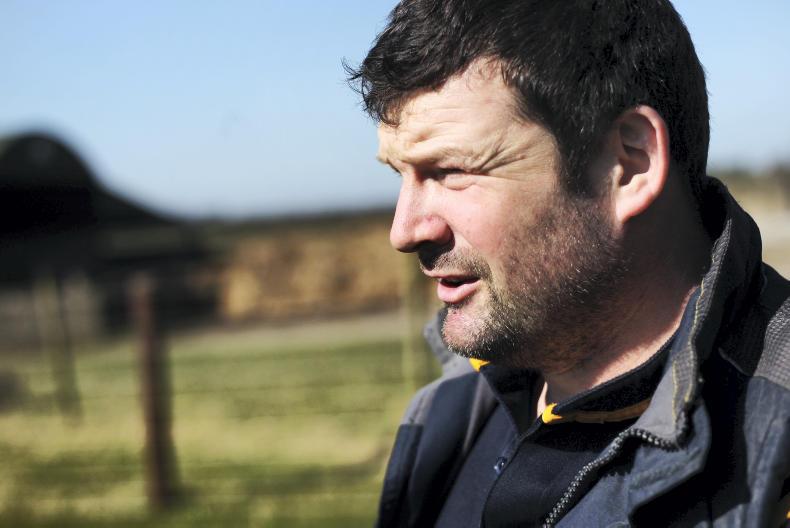


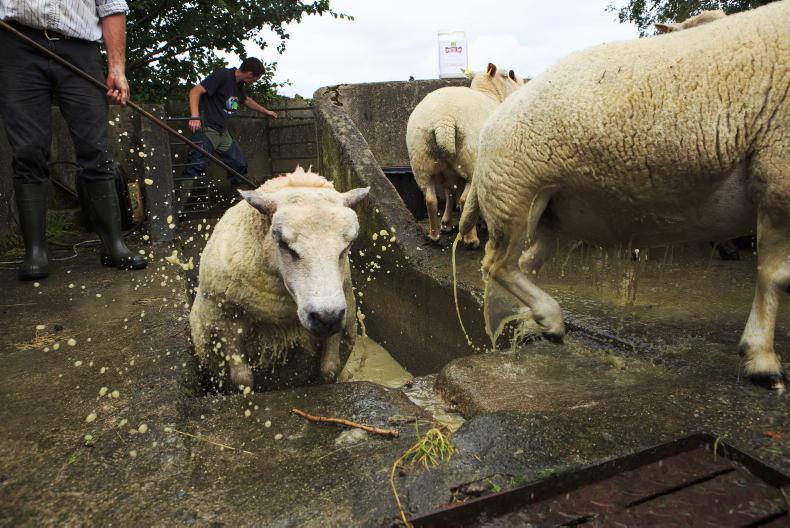
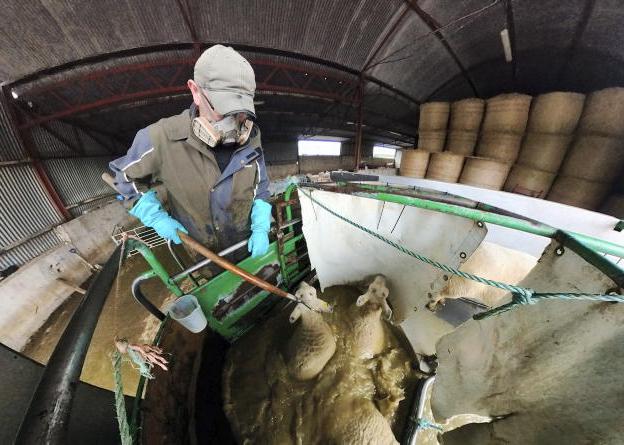
SHARING OPTIONS